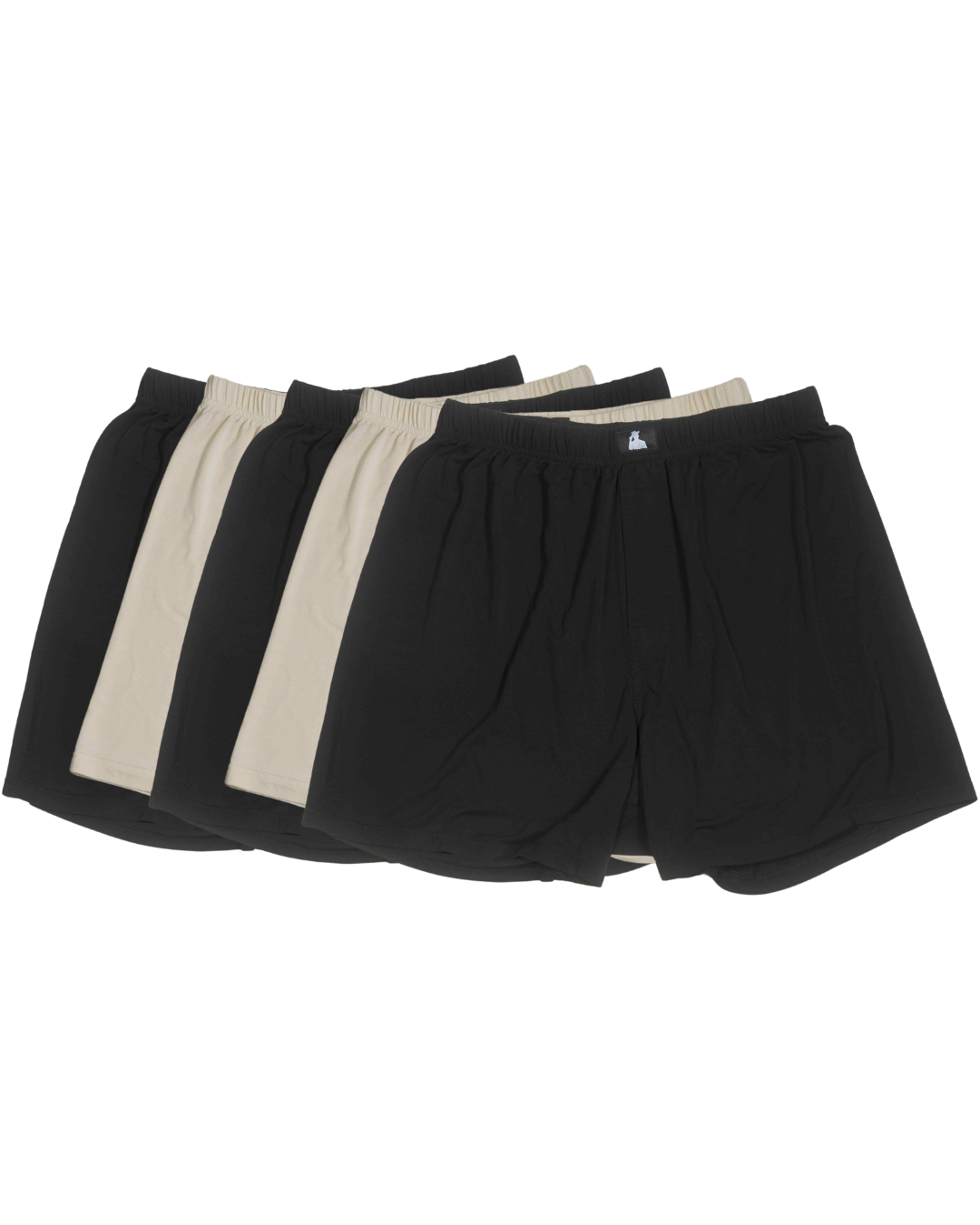Polyester vs. Fertility: The Hidden Risks of Synthetic Fabrics
Written By The Mr. Fertyl Research & Education Team
Clothing might seem unrelated to reproductive health, but emerging evidence suggests that the fabrics we wear could quietly influence fertility. Polyester and other synthetic materials have become ubiquitous in wardrobes for their durability and stretch. However, researchers are now examining whether these convenient fabrics carry hidden risks for those hoping to start a family. From increased heat retention in the groin to chemical exposure from fabric treatments, polyester underwear may pose an avoidable threat to long-term fertility. This conversation has long been under the radar, and normalizing it can empower men (and women) to make informed, health-conscious choices about their clothing. In this article, we’ll explore the science linking polyester to reproductive health issues – particularly male fertility – and discuss why switching to natural alternatives like Bamboo Lyocell could make a real difference.
How Polyester Could Impact Reproductive Health
Modern medicine recognizes a variety of lifestyle factors that affect fertility, and clothing choice is gaining attention on that list. The main concerns with polyester and similar synthetic fabrics include:
- Overheating of Testicles: Polyester is not very breathable, which traps heat. Healthy sperm production requires the testes to stay slightly cooler than core body temperature (about 2–4°C lower) [7]. Even a minor increase in scrotal temperature can impair sperm formation and function [7]. Tight or non-breathable garments exacerbate this risk by preventing heat dissipation. Studies confirm that wearing snug, synthetic underwear can raise testicular temperature by roughly 0.5–0.8°C [7]. This may sound small, but it could be enough to inhibit spermatogenesis (sperm development) over time [7]. Notably, a large 2018 study of 656 men found those who primarily wore loose cotton boxer shorts had 25% higher sperm concentration and 17% higher total sperm count than men who wore tight-fitting underwear [9]. The boxer-wearing men also had significantly lower levels of follicle-stimulating hormone (FSH), suggesting their bodies weren’t straining to compensate for heat damage to the testes [9]. These findings underscore that cooler, breathable attire (like boxers or natural fabrics) can positively affect male fertility. By contrast, polyester’s heat-trapping nature may contribute to chronically warmer testicles and reduced sperm quality.
- Electrostatic Charge and Fabric Factors: Interestingly, the risks of polyester go beyond just heat. Research by Egyptian surgeon Dr. Ahmed Shafik in the 1990s explored fabric effects on fertility using both animal and human experiments. In one study, Shafik dressed two groups of dogs in underpants – one group in cotton, the other in polyester – for 24 months [1]. The polyester-wearing dogs showed a significant decrease in sperm count and motility and an increase in abnormal sperm forms, while the cotton-wearing dogs and a control group had no such changes [1]. The dogs’ semen parameters largely recovered after the polyester garment was removed, indicating the effect was reversible [1]. Strikingly, the testicular temperature did not differ significantly between the polyester and cotton groups in this study, since the garments were designed to be loose [1]. This led Shafik to propose that electrostatic charges generated by polyester fibers rubbing the skin might impair sperm production [1]. In a follow-up trial on humans, 14 healthy men wore a polyester sling around their scrotum continuously as a contraceptive test [2]. Amazingly, all men became azoospermic (zero sperm count) after about 140 days, effectively rendering them infertile until the sling was removed [2]. No hormonal changes were detected, again pointing to a local fabric effect [2]. Within several months after removing the polyester sling, the men’s sperm counts recovered to normal and their partners were able to conceive [2]. While these experiments are unusual and would need broader confirmation, they highlight that polyester’s impact on fertility is not just an old wives’ tale – the fabric itself can directly interfere with testicular function in some cases.
- Chemical Exposure from Synthetic Materials: Polyester is a form of plastic (polyethylene terephthalate), and synthetic textiles often contain a slew of chemical additives from manufacturing or finishing processes. These can include dyes, plasticizers, flame retardants, water-proofing agents, and more. Scientists are concerned that prolonged skin contact with such substances might introduce endocrine-disrupting chemicals (EDCs) into the body [5]. For instance, water-resistant polyester clothing may be treated with PFAS (per- and polyfluoroalkyl substances) – nicknamed “forever chemicals” – to repel stains or moisture. PFAS are notorious EDCs that accumulate in the body. According to the U.S. National Institute of Environmental Health Sciences, women with high blood levels of PFAS had up to 40% lower fertility, measured as reduced chances of pregnancy and live birth in one study [5]. PFAS exposure has also been linked to higher rates of endometriosis and polycystic ovary syndrome in women [5] – conditions that can cause infertility. Men are not off the hook either; many EDCs like PFAS or phthalates are suspected of contributing to declining sperm counts and quality in the general population [6]. Polyester fabrics can contain phthalates (used to make plastics soft and flexible) and residues of bisphenol-A (BPA) (used in some polyester-blend fibers and spandex) [5]. Both chemicals are proven endocrine disruptors. A 2021 review in a reproductive medicine journal found that higher concentrations of phthalates were associated with lower pregnancy rates and increased miscarriage incidence in couples [5]. Likewise, BPA exposure has been correlated with hormonal imbalances; for example, women with the highest BPA levels in their blood had a higher prevalence of PCOS, a hormone-driven infertility condition [5]. While it’s hard to pin these problems on clothing alone (people encounter phthalates and BPA from many sources like food packaging), the fact that polyester garments could leach such chemicals onto the skin is worrying. Over time, and especially when worn in tight contact with sensitive areas, synthetic fabrics might contribute to one’s overall chemical exposure load [5].
- Microplastics and Reproductive Health: An environmental angle to this issue is the release of microplastics – tiny fibers and particles – from synthetic clothing. Every time we wash or wear polyester, microscopic plastic fibers shed into water or air. These microplastics have now been detected in human blood, placentas, and even sperm fluid. Early research indicates they could act as yet another stressor on fertility. In animal studies, microplastic exposure led to reduced sperm counts and hormonal disruption [10]. A recent review in the American Journal of Men’s Health warned that microplastics may significantly degrade male semen quality and therefore “may be a significant cause of male infertility” [8]. The science on microplastics in human fertility is still nascent, but given that polyester is essentially a form of plastic, it’s reasonable to be cautious. Choosing natural fiber clothing helps reduce the microplastic burden on the environment and potentially on your body as well.

Stay Cool. Stay Fertyl.
Shop Mr. FertylWhy Fabric Choice Matters for Fertility
Fertility specialists often emphasize “keeping it cool” when it comes to male reproductive health. There’s a reason nature positioned the testes outside the body – sperm production operates optimally a few degrees below normal body temperature [7]. Any habit that consistently warms the groin (whether it’s frequent hot tubs, placing a laptop on your lap, or yes, wearing stifling underwear) can impair sperm output [4][7]. In fact, some urologists consider genital heat stress one of the key modifiable factors in male infertility. Heat aside, we now understand that chemical exposures play a role in reproductive success for both men and women [4][6]. Reducing contact with hormone-disrupting chemicals – including those possibly present in clothing – is increasingly recommended as a precaution for couples trying to conceive [5]. The bottom line is that fabric choice is an easy lifestyle tweak that could help tip the odds in your favor. Unlike some risk factors that are hard to control, you can choose what you put on your body every day.
Critically, even if the fertility impact of polyester is subtle for an average person, it can be significant for someone already struggling with borderline sperm counts or hormonal issues. Doctors from Harvard and elsewhere note that switching to looser, breathable underwear is a no-cost, no-regret intervention – it might help, and certainly won’t hurt [7][9]. As Dr. Lidia Mínguez-Alarcón, lead author of the 2018 underwear study, concluded, “men can modify the type of underwear they choose to wear” as a practical step to improve testicular function [9]. Some experts (including a Mayo Clinic commentary) point out that not all studies agree on how much underwear style affects fertility, especially in men with no underlying issues [11]. But given the potential stakes and the minimal effort involved, many fertility specialists err on the side of caution – advising patients to avoid tight or synthetic fabrics around the groin when trying for a baby. It’s an easy win for reproductive wellness and even general comfort.
Bamboo Lyocell and Other Fertility-Friendly Alternatives
The good news is that avoiding polyester doesn’t mean sacrificing comfort or style. Natural and innovative eco-friendly fabrics are readily available as healthier alternatives. Cotton has long been recommended by doctors for undergarments because it’s breathable and absorbent, helping keep the genital area cool and dry (thus discouraging both heat buildup and infections). For those looking beyond cotton, Bamboo Lyocell is an up-and-coming superstar fabric that is particularly suited for men concerned about fertility and health. Bamboo Lyocell is a form of bamboo fabric derived from bamboo pulp through a non-toxic process, resulting in a fabric that is ultra-breathable, moisture-wicking, and thermoregulating. In other words, it allows airflow and pulls sweat away from the skin, creating a cooler and more comfortable microclimate compared to polyester. Many users find that bamboo-derived fabrics feel softer than cotton while staying just as cool in hot weather. Importantly, Bamboo Lyocell is naturally gentle on skin and typically doesn’t require harsh chemical finishes, so you avoid some of the unwanted exposures that come with synthetic clothing.
Mr. Fertyl’s Bamboo Lyocell underwear is a prime example of how fabric choice can align with fertility goals. These undergarments are specifically designed for health-conscious, fertility-focused men who refuse to compromise on quality or the environment. By using Bamboo Lyocell, Mr. Fertyl’s products ensure optimal breathability and temperature control, helping to keep testicles at a sperm-friendly temperature. They are also free of known toxic additives – there are no PFAS treatments or heavy synthetic blends, so wearers can have peace of mind about chemical exposure. As a bonus, bamboo is a sustainable resource, and the lyocell manufacturing process is eco-friendly, meaning you’re supporting environmental well-being along with your own reproductive well-being. For men who have been wearing polyester or nylon underwear for years, making the switch to a fabric like Bamboo Lyocell often results in immediate comfort improvements (less sweating and chafing) and potentially long-term fertility benefits. It’s a simple change that aligns with a broader preventive approach: controlling what you can, in order to safeguard something as precious as your ability to have children.

Polyester Heats.
Shop Bamboo LyocellConclusion
Polyester may be a common fabric, but when it comes to fertility, it appears to be a common culprit we don’t talk enough about. Scientific findings – from dog studies to large human trials – have revealed multiple mechanisms by which synthetic fabrics could undermine reproductive health. Increased scrotal heat, electrostatic interference with sperm production, and exposure to embedded chemicals all paint polyester in a concerning light for someone planning a family. While research is ongoing and we’re still learning the full extent of these effects (the “jury is still out,” as some say [5]), there is already a convincing case for caution. Fertility challenges are often multifactorial, so eliminating one potential risk factor – especially an avoidable one like clothing material – simply makes good sense.
By choosing natural, fertility-safe fabrics, you can create a cooler and cleaner environment for your reproductive organs. It’s an empowering action in a journey that sometimes leaves people feeling helpless. If you’re trying to conceive or even just thinking ahead, consider giving your underwear drawer a health makeover. Opt for boxers or looser briefs made from Bamboo Lyocell or other breathable fibers, and save the tight polyester workout shorts for short-term use only (or ditch them altogether). Such changes might very well improve sperm count or quality over time, as some studies suggest, and at the very least they will keep you more comfortable. Equally important, you’ll reduce contact with substances that don’t belong anywhere near your hormones or private parts.
Fertility is a long-term investment, and seemingly small choices can have hidden payoffs. Polyester’s potential risks are largely hidden but avoidable, as we’ve now uncovered. With growing awareness, men no longer need to silently wonder if their clothing is affecting their manhood – they can talk about it, switch things up, and even encourage friends to do the same. In a world full of fertility advice (eat this, take that supplement, avoid stress, etc.), here’s one more tip to add: wear the right fabric. Your future family might thank you for it.
- Shafik, A. (1993). Effect of different types of textile fabric on spermatogenesis: An experimental study. Urological Research, 21(5), 367–370. Source.
- Shafik, A. (1992). Contraceptive efficacy of polyester-induced azoospermia in normal men. Contraception, 45(5), 439–451. Source.
- Mínguez-Alarcón, L., Gaskins, A. J., Chiu, Y. H., et al. (2018). Type of underwear worn and markers of testicular function among men attending a fertility center. Human Reproduction, 33(9), 1749–1756. Source.
- Cleveland Clinic. (2019, September 17). How to Increase Sperm Count and Improve Male Fertility. Cleveland Clinic – Health Essentials. Source.
- Novak, S. (2023). Fabrics like polyester can contain a number of chemicals that might impact fertility. Discover Magazine. Source.
- Wallis, C. (2023, March 1). Common chemicals may harm sperm and pregnancies, growing evidence shows. Scientific American. Source.
- McVean, A. (2020, September 2). Facts and myths of male fertility: Tight underwear, hot tubs, marijuana, and more. McGill Office for Science and Society. Source.
- Zhang, C., Chen, J., Ma, S., Sun, Z., & Wang, Z. (2022). Microplastics may be a significant cause of male infertility. American Journal of Men’s Health, 16(3), 1–4. Source.
- European Society of Human Reproduction and Embryology. (2018, August 9). Largest study yet shows type of underwear is linked to men’s semen quality. ScienceDaily. Source.
- Carrington, D. (2024, June 10). Microplastics found in every human semen sample tested in Chinese study. The Guardian. Source.
- Ogle, A. (2019, March 1). Boxers or briefs? 4 common fertility myths debunked. Mayo Clinic Health System. Source.

